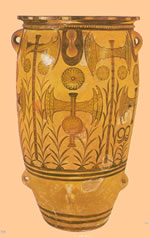One finds here a Wooden Model of the Palace of Knossos as well as more frescoes, including The Saffron Gatherer, first believed to have been a depiction of a boy, but now accepted as a blue monkey, and shown in two adjacent versions; The Captain of the Blacks, dated from the end of the New Palace period, and showing African soldiers (possibly Sudanese mercenaries) lead by a Minoan officer, a fresco that reflects the militarism of this new era in Crete.
Back downstairs: The Yiamalakis Collection of a doctor of Herakleion, which includes a figurine of (possibly) a Neolithic fertility goddess of the 'steatopygous' (fat-buttocked) type found near Ierapetra on the south coast of Crete; a Bull's Head of gold and other pieces from the Zakros Treasure; bronze and ceramic miniatures, and later Roman figures and a floor mosaic.
From 650 B.C. -400 A.D. Archaic period up to the division of the Roman Empire. Wide variety of styles and items.
Larger pieces from Archaic period (650-500 B.C. Bronze figurines from the sanctuary of Apollo Delphinios at Dreros of Artemis with their mother Leto. Made from hammered bronze sheets riveted together.
Classical Greek and Greco-Roman sculpture.
 A Few other Items of Interest
A Few other Items of InterestFenced open area opposite Museum: collection of inscriptions.
Archaeological collection of Archanes. Glyptotheke of Gortyn-at arch. From site of Gortyn Bull-Leaping Fresco: found Palace of Knossos. Shows bull-leaping, a kind of contest, prob. Relig. In char. in which both men and women took part. Man shown jumping over back of bull with female figure on each side. 17-15th centuries B.C. Gold ring from Isopata: found in atomb at Isopata, in vicinity of Knossos. Women in ecstatic ritual dance in a meadow with lilies (shown on bezel). Smaller figure believed to be a goddess descending from the sky. On ground signs of an eye and snakes. Masterpiedce of Minoan goldwork, 15th cent. B.C. Fruitstand of the 'Kamares Style': from Palace at Phaistos. Decorated with painted, multi-colored, spiral patterns and rim adorned with a toothed fringe. 18-17th century B.C.) Clay model of shrine from Giamalakis collection: Terracotta model of circular shrine found Archanes. Opening closed by a detachable door. Inside a seated female figure with raised arms, poss. A goddess. Two human figures on roff, perhaps representing worshipers, watch the goddess through the lightwell; a dog lies near edge. Proto-geometric period 10-9th century B.C. Bronze statuettes: three statuettes of hammered br. Sheetes from Temple of Apollo Delphinios at Dreros. Prob. depict Apollo, his sister Artemis and their mother Leto. First known case of hammered bronze in statues. End 8th cent. B.C. Statue of Aphrodite: Marble from Gortyn, representing Aphrodite kneeling in her bath. A Roman copy of a Hell. Orig. by sculptor Doidalsas. 1st cent. B.C.